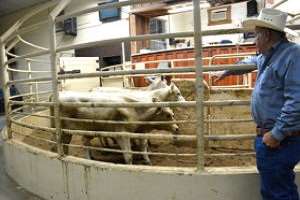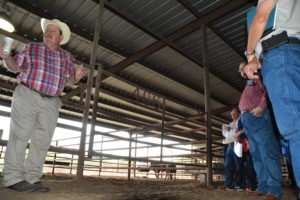Spiraling cattle prices in recent weeks are not leaving much wiggle room when it comes to marketing calves and replacement females to fit current trends, according to cattle experts.

The recent Brazos Valley Beef and Forage Expo held at the Brazos Valley Livestock Commission featured talks that included purchasing replacement heifers, evaluating feeder cattle and marketing the right type of cattle to achieve maximum profits. The program was sponsored by the Texas A&M AgriLife Extension Service beef and forage committee.
“One of the traits we are looking for when purchasing replacement heifers is docility and temperament,” said Dr. Joe Paschal, AgriLife Extension beef cattle specialist, Corpus Christi. “I want my heifers to be calm and to protect her calf. I don’t want her to run away from me or try to run over me as I approach.”
Paschal suggests talking to local sale barn operators to find out what buyers are wanting in calves marketed each week. That will give the beef producer key insight as to which breeds or crossbreeds of replacement heifers to consider when buying.
“After all, why not produce what the market wants?” Paschal said.
Ideally, Pascal said producers should be developing heifers to calve at 24 months. Most beef producers like to have crossbred heifers in their herd because of hybrid vigor. A popular option is a Brahman and Hereford cross or Brahman and Angus cross. Both these combinations have hybrid vigor, which Paschal said, “is like having an insurance program giving you a greater chance of having them bred and calving at 24 months.
“Structural soundness is also important,” he said. “We want heifers that have good frame size and the ability to calve with ease.”
One thing to keep in mind is annual cow cost. Paschal said the average cow cost is $600 annually, which includes feed and taxes.

“One thing that drives up the cost of replacement heifers is hay and purchased feed,” Paschal said. “In some parts of Texas, you can get away with not feeding any hay at all. In my area in South Texas, I don’t feed any hay at all. I stockpile forage and utilize rotational grazing. That helps keep my annual cow cost in line. But for those in South Central Texas, it can be cold, muddy and nasty during the winter, so you have to feed hay. Just keep in mind how expensive hay is to produce or purchase. There are feeding strategies that can be developed to keep those costs in check.”
Meanwhile, Pete Scarmardo, owner of Brazos Valley Livestock Commission, told attendees cattle prices have been very volatile.
“The futures market has been used more as a trading tool than a speculative tool,” he said. “That’s made things very difficult for the cattle market. Somewhere, we will reach a bottom.”
Through October, fed cattle prices continued to trend lower, he said.
“We’ve got to get some equity back into these cattle,” he said. “We have no bargaining power in the cash market. Until we reach a peak in the cattle supply, the U.S. dollar gets weaker, our industry has some big problems. There are a lot of people who have lost money over the last 18 months.”